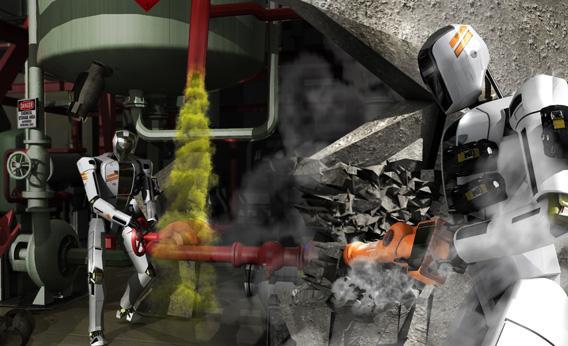Today, DARPA released details about its upcoming Robotics Challenge, which comes with a $2 million purse. The task: create a robot that can assist in disaster recovery. DARPA’s press release says that competing teams’ creations will be put through “staged disaster-response scenarios in which robots will have to successfully navigate a series of physical tasks corresponding to anticipated, real-world disaster-response requirements.”
“The robots themselves don’t need to take a human form, but many of the tasks DARPA’s challenge addresses favor robots in humanoid form,” Martin LaMonica notes on Cnet’s Cutting Edge blog. But “humanoid” doesn’t have to mean a straight mechanical translation of the human form: “[R]oboticists say they may also lead to the robotic equivalent of the Minotaur—a hybrid creature that might have multiple arms and not just legs but treads,” John Markoff says in the New York Times.
Robots were used in the wake of the Fukuishima disaster (one operator wrote an anonymous blog about his work), but current technology meant that their role was somewhat limited.
According to the official announcement (PDF), tasks the robots may have to perform include:
1. Drive a utility vehicle at the site.
2. Travel dismounted across rubble.
3. Remove debris blocking an entryway.
4. Open a door and enter a building.
5. Climb an industrial ladder and traverse an industrial walkway.
6. Use a tool to break through a concrete panel.
7. Locate and close a valve near a leaking pipe.
8. Replace a component such as a cooling pump.
Speaking of task No. 1, drive a vehicle: James Donlon, program manager for DARPA’s Mind’s Eye program, recently discussed the challenges of machine vision at the Embedded Vision Alliance. During his talk, Venture Beat’s Dean Takahashi says, Donlon noted “that vision systems being tested now aren’t that bad at recognizing patterns such as a person about to be hit by a car that is backing up. But they still make mistakes that are sometimes comical, like mistaking a stationary object for a person or focusing on the wrong thing in a scene.”
Keep those lessons in mind, would-be Robotics Challenge participants.
